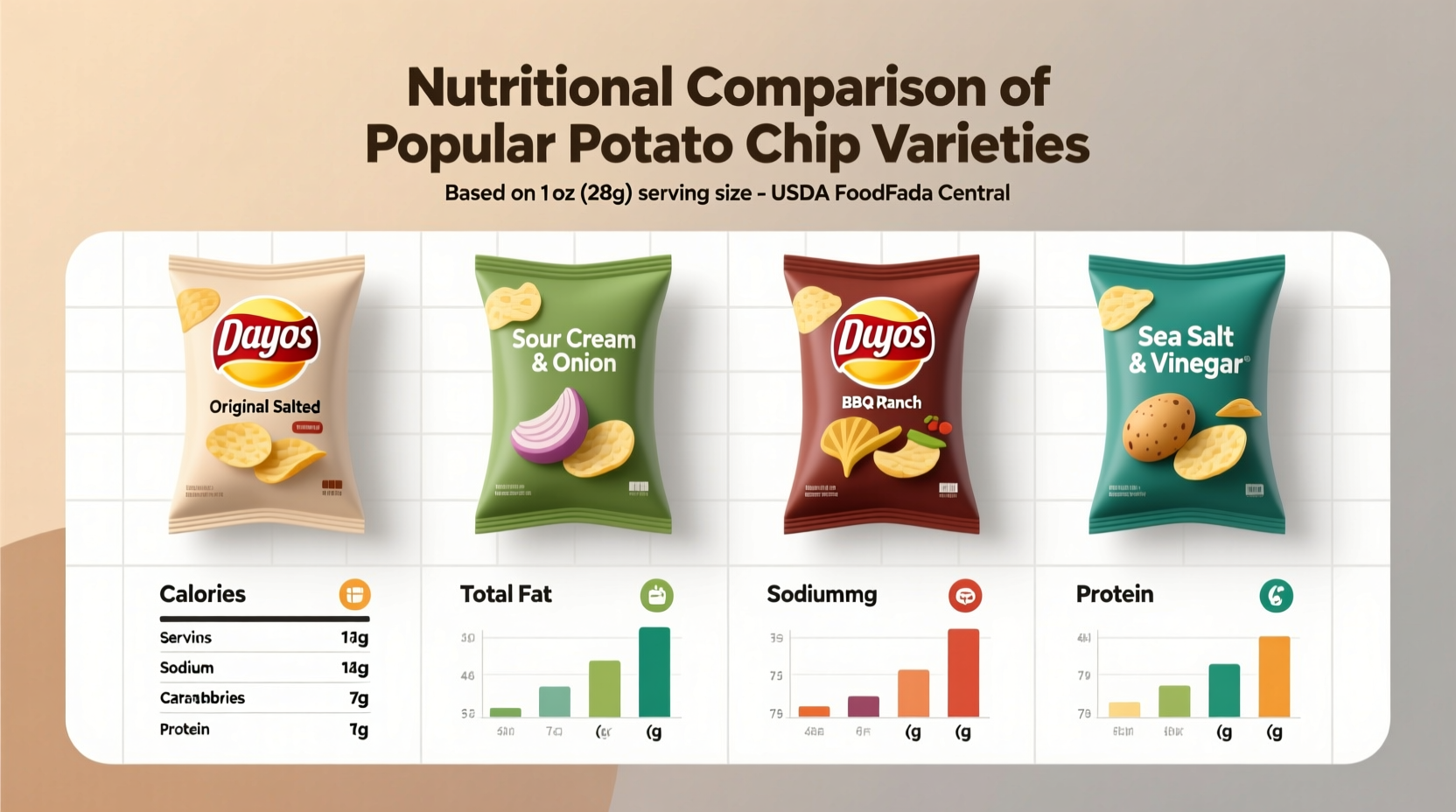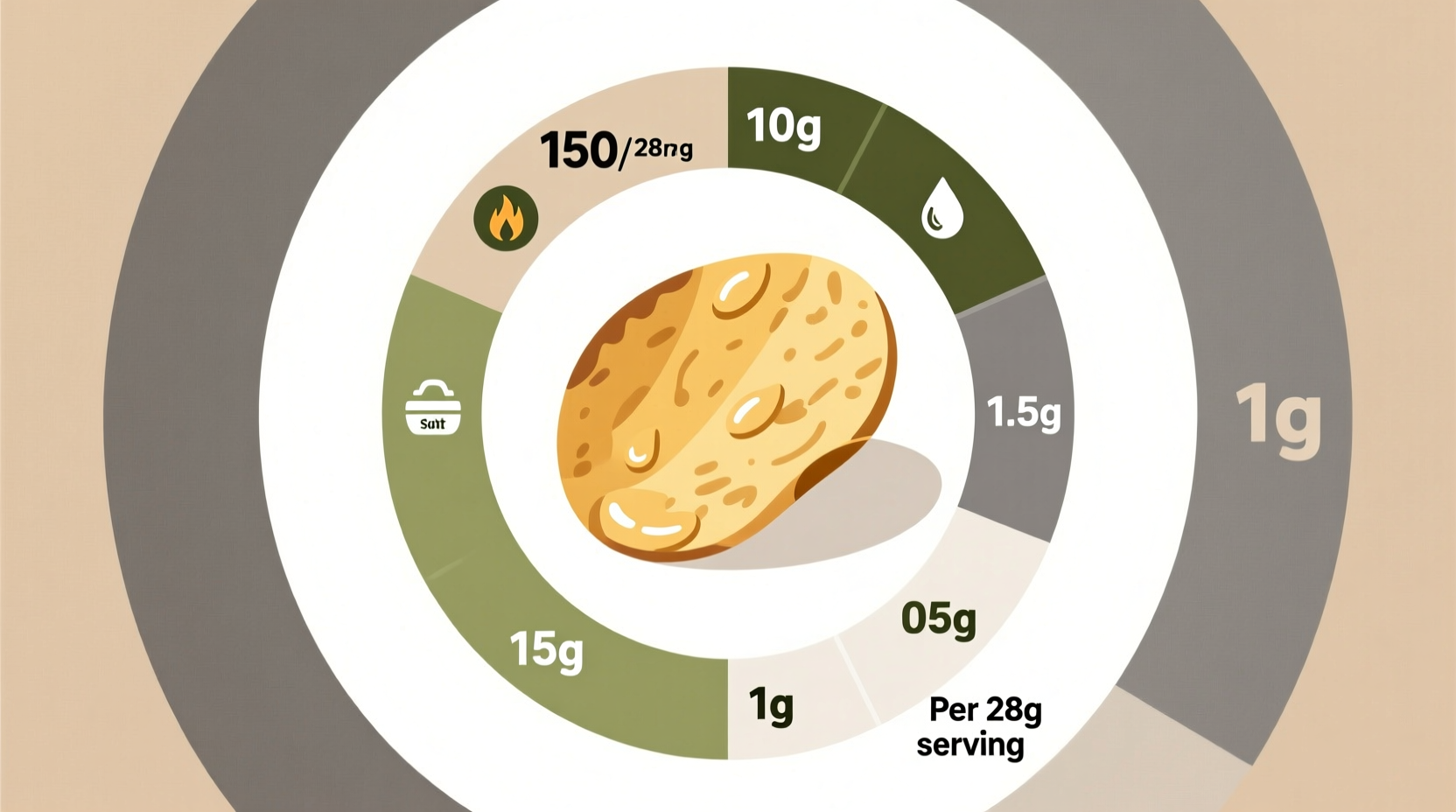When you reach for that bag of potato chips, you're probably not thinking about the precise nutritional composition. But understanding what's really in your favorite snack can help you make smarter choices without sacrificing enjoyment. Let's break down exactly what you're consuming and how different varieties compare.
What's Inside a Standard Serving of Potato Chips?
Before diving into variations, it's essential to establish baseline nutritional values. The standard serving size for potato chips is 1 ounce (28 grams), which equals about 15-20 chips depending on the brand and cut. This seemingly small portion packs a nutritional punch that many consumers underestimate.
| Nutrient | Amount per 1 oz (28g) | % Daily Value* |
|---|---|---|
| Calories | 152 | 8% |
| Total Fat | 10g | 13% |
| Saturated Fat | 1.5g | 8% |
| Carbohydrates | 15g | 5% |
| Fiber | 1g | 4% |
| Sugar | 0g | 0% |
| Sodium | 170mg | 7% |
| Protein | 2g | 4% |
*Percent Daily Values are based on a 2,000 calorie diet. Your daily values may be higher or lower depending on your calorie needs. Source: USDA FoodData Central
How Different Potato Chip Varieties Compare Nutritionally
Not all potato chips are created equal. The preparation method significantly impacts the nutritional profile. Let's examine how popular varieties stack up against each other:
- Regular fried chips: The classic version delivers that satisfying crunch but comes with higher fat content from the deep-frying process
- Kettle-cooked chips: Often thicker and crunchier, these typically contain 10-15% more fat than regular chips due to longer frying times
- Baked chips: Processed with less oil, these offer approximately 30% fewer calories and 50% less fat than traditional fried varieties
- Thinly sliced chips: Despite their delicate texture, these often contain similar nutritional values to regular chips
- Organic or "natural" chips: These may avoid artificial ingredients but frequently have comparable calorie and fat content to conventional options
Research from the USDA FoodData Central shows that while baked alternatives reduce fat content, they sometimes compensate with slightly higher sodium levels to maintain flavor. This trade-off is important to consider when evaluating "healthier" options.
Understanding the Health Implications of Potato Chip Consumption
Occasional potato chip enjoyment fits within a balanced diet, but regular consumption requires awareness of potential health impacts. The primary concerns stem from three components: fat content, sodium levels, and the glycemic response from the carbohydrates.
A 2022 study published in the American Journal of Clinical Nutrition examined the relationship between potato chip consumption and metabolic health. Researchers found that while moderate consumption (once or twice weekly) showed minimal negative impact, daily consumption correlated with increased waist circumference and higher triglyceride levels over time.
The type of fat matters significantly. Most potato chips contain primarily unsaturated fats from the cooking oil, which are preferable to saturated fats. However, the high-heat frying process can create small amounts of trans fats, even in products labeled "0g trans fat" (as labeling regulations allow this claim when trans fat is less than 0.5g per serving).

Practical Strategies for Enjoying Potato Chips Mindfully
You don't need to eliminate potato chips entirely to maintain a healthy diet. Consider these practical approaches that balance enjoyment with nutritional awareness:
Portion Control Techniques
Instead of eating directly from the bag, measure a single serving (1 ounce) into a small bowl. This simple act increases awareness of consumption quantity. Research from Cornell University's Food and Brand Lab shows that visual portion cues reduce overall consumption by 20-30% compared to eating from large containers.
Smart Pairing Strategies
Combine your potato chips with protein or fiber-rich foods to slow digestion and increase satiety. Try these combinations:
- Add a small serving of hummus or Greek yogurt dip
- Pair with sliced vegetables like cucumber or bell peppers
- Include alongside a lean protein source like grilled chicken
Reading Labels Effectively
When selecting potato chips, look beyond the front-of-package claims. Check the actual nutrition facts panel and ingredient list. Products claiming "30% less fat" might still contain significant amounts of fat, just less than their regular counterpart. Similarly, "no artificial flavors" doesn't necessarily mean lower in calories or sodium.
How Potato Chips Fit Within a Balanced Diet
Dietary guidelines from the U.S. Department of Agriculture recommend that discretionary calories (those from foods not essential for meeting nutrient needs) should account for only 5-15% of total daily calories. For a 2,000-calorie diet, this means 100-300 discretionary calories per day.
A single serving of potato chips (152 calories) represents approximately 75% of the lower end of this discretionary allowance. This context helps explain why moderate consumption fits within healthy eating patterns, while regular large portions can quickly displace more nutrient-dense foods.
Nutrition experts emphasize that no single food determines overall health. The key is considering potato chips within your complete dietary pattern. As registered dietitian Marion Nestle explains, "It's the overall dietary pattern that matters, not individual foods. Occasional treats fit within healthy eating when balanced with nutrient-rich foods most of the time."











 浙公网安备
33010002000092号
浙公网安备
33010002000092号 浙B2-20120091-4
浙B2-20120091-4